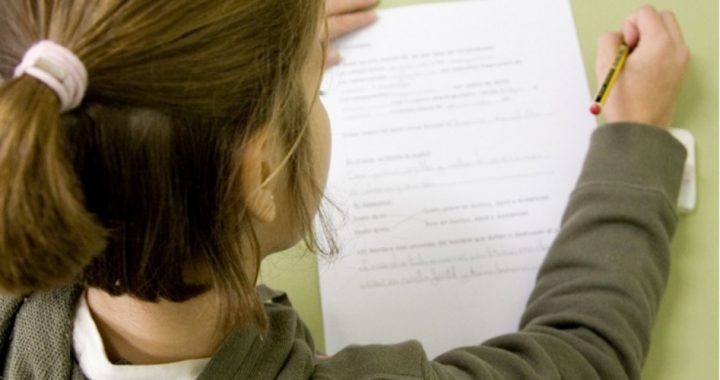
After years of pushing for more standardized testing in public schools, the Obama administration announced October 24 that it wants to reduce the number of tests students must take and even limit the amount of time they may spend on them.
“In moderation, I believe smart, strategic tests can help us measure our kids’ progress in school,” President Barack Obama stated in an open letter to parents and teachers. “As a parent, I want to know how my kids are doing, and I want their teachers to know that, too. As President, I want to hold all of us accountable for making sure every child, everywhere, is learning what he or she needs to be successful.”
Clearly, despite his talk of cutting back on testing, Obama has no intention of relinquishing any of the federal government’s control over the education system. He wants, he said, “tests that are worth taking — tests that are high quality, aimed at good instruction, and make sure everyone is on track.” Bureaucrats in Washington, of course, will decide which tests are “worth taking” and force states to comply.
The president also declared that “tests shouldn’t occupy too much classroom time, or crowd out teaching and learning.” To that end, the administration is calling for states — and, if possible, Congress — to impose “a cap on the percentage of instructional time students spend taking required statewide standardized assessments to ensure that no child spends more than 2 percent of her classroom time taking these tests,” according to a Department of Education Fact Sheet.
In addition, wrote Obama, “tests should be just one source of information. We should use classroom work, surveys, and other factors to give us an all-around look at how our students and schools are doing.”
The heavy regimen of federally mandated standardized testing began with the 2001 No Child Left Behind Act, a law passed by a Republican Congress and signed by Republican President George W. Bush. Obama upped the ante with his $4.3-billion Race to the Top program, which offered cash to states for, among other things, evaluating teachers on the basis of tests and adopting common education standards (i.e., Common Core). Then the administration shelled out $360 million to create new standardized tests based on Common Core; these were supposed to be better assessments than those previously employed. Now, with students subjected to an average of 112 mandatory standardized tests over the course of their school years (according to a report released Saturday by the Council of the Great City Schools), the Education Department says America needs “fewer and smarter assessments.”
Parents, students, teachers, and schools had begun to revolt against the testing regime, and undoubtedly some of this played into the administration’s recent announcement. Probably the biggest factor, though, was lobbying from teachers’ unions, which the New York Times said “had led the opposition on the left to the amount of testing” and “declared the reversal of sorts a victory.”
The main reason for the unions’ opposition is that the tests were reflecting poorly on teachers. As the New Yorker pointed out, “As they are currently administered at least, test results are most meaningful in aggregate. This has lead [sic] to their use and overuse in measuring not the abilities of individual children but, rather, the performance of teachers and educational institutions.” Teachers griped to their union bosses, who in turn complained to their allies in the administration, which then announced the scaling back of the testing regime.
Many in the press and blogosphere are referring to the administration’s seeming change of heart as a radical reversal of policy. “Rigorous testing was so fundamental to the Obama Administration’s education reform agenda that this repudiation resembles shutting down Obamacare or the EPA’s carbon pollution regulations,” wrote Salon’s David Dayen.
Not everyone, however, was so taken with the announcement. Valerie Strauss of the Washington Post made an excellent case that “the solutions offered by the administration … don’t much move the needle. They won’t cut into testing time and test prep all that much, if at all, and they won’t eliminate what is arguably a bigger problem: the high stakes associated with the exams.”
After noting how much the administration had contributed to the problem — something even the Education Department tepidly admitted in its Fact Sheet — Strauss observed that the administration’s proposed two-percent cap on testing time isn’t really much of an improvement over the status quo. The Council of Great City Schools study found that students are spending an average of 2.3 percent of their time on tests now. That means that in many states students are spending far less than two percent of their time on tests, so the cap won’t mean much to them; indeed, it could open the door to even more testing.
The two-percent figure was selected as the optimal limit primarily because New York already has a law with that more-or-less arbitrary ceiling in place. Yet Tim Farley of New York State Allies for Public Education calculated that most students in the Empire State are spending about nine hours a year, or 0.8 percent of their time, filling in bubble sheets now, meaning they’d have to put in another 14.4 hours of testing per year to reach the mandated limit. “A 2% cap isn’t a step forward,” wrote Farley, “it’s a giant leap backward.”
Furthermore, the administration wants to enshrine this two-percent cap in federal law. Strauss is properly skeptical: “Do we really want Congress — which passed No Child Left Behind and its testing mandates — to stay involved in how much testing time students have in school? How would a reasonable cap be decided anyway, given the different views people hold on the value of testing?”
Strauss also noted that the administration’s plan “does not … recommend a specific limit on test prep time” but merely calls for the elimination of “drill-and-kill” test preparation. Nor does the plan “call for the elimination of using standardized test scores to evaluate educators,” according to Strauss. As long as the tests still have high stakes, schools are going to remain under pressure to “drill-and-kill” students until they can pass them.
The Times pointed to other pitfalls of the plan. It “risks creating new uncertainty on the role of tests in America’s schools,” and “the cap on time spent testing” could “tangle schools in more federal regulations and questions of what, exactly, counts as a test.”
“There’s plenty of agreement that there’s too much testing going on,” Michael Petrilli, president of the Thomas B. Fordham Institute and a testing proponent, told the paper. “[But] we have to be careful, as with anything federal, that it doesn’t lead to unintended consequences.”
As usual, the best way to avoid these unintended consequences is to subject the proposal to the one test that applies to all federal actions: Do they comport with the Constitution? Since all federal involvement in education flunks this exam, it should simply be expelled from the law books, leaving states and local school districts free to set standards that best meet their needs.



